Save 33% on the Elements 2026 bundle. Ends 1/2.* CAD$130.99
- Get to know Premiere Elements
- Adobe Premiere Elements User Guide
- Introduction to Adobe Premiere Elements
- Workspace and workflow
- Working with projects
- 360° and VR Video Editing
- Importing and adding media
- Arranging clips
- Editing clips
- Reduce noise
- Select object
- Candid Moments
- Color Match
- Color Fonts and Emojis
- Smart Trim
- Freehand Crop
- Delete All Gaps
- Change clip speed and duration
- Split clips
- Freeze and hold frames
- Adjusting Brightness, Contrast, and Color - Guided Edit
- Stabilize video footage with Shake Stabilizer
- Replace footage
- Working with source clips
- Trimming Unwanted Frames - Guided Edit
- Trim clips
- Editing frames with Auto Smart Tone
- Artistic effects
- Color Correction and Grading
- Applying transitions
- Special effects basics
- Effects reference
- Applying and removing effects
- Create a black and white video with a color pop - Guided Edit
- Time remapping - Guided edit
- Effects basics
- Working with effect presets
- Finding and organizing effects
- Editing frames with Auto Smart Tone
- Fill Frame - Guided edit
- Create a time-lapse - Guided edit
- Best practices to create a time-lapse video
- Applying special effects
- Use pan and zoom to create video-like effect
- Transparency and superimposing
- Reposition, scale, or rotate clips with the Motion effect
- Apply an Effects Mask to your video
- Adjust temperature and tint
- Create a Glass Pane effect - Guided Edit
- Create a picture-in-picture overlay
- Applying effects using Adjustment layers
- Adding Title to your movie
- Removing haze
- Creating a Picture in Picture - Guided Edit
- Create a Vignetting effect
- Add a Split Tone Effect
- Add FilmLooks effects
- Add an HSL Tuner effect
- Fill Frame - Guided edit
- Create a time-lapse - Guided edit
- Animated Sky - Guided edit
- Select object
- Animated Mattes - Guided Edit
- Double exposure- Guided Edit
- Special audio effects
- Movie titles
- Creating titles
- Adding shapes and images to titles
- Adding color and shadows to titles
- Apply Gradients
- Create Titles and MOGRTs
- Add responsive design
- Editing and formatting text
- Text Styles and Style Browser
- Align and transform objects
- Motion Titles
- Appearance of text and shapes
- Exporting and importing titles
- Arranging objects in titles
- Designing titles for TV
- Applying styles to text and graphics
- Adding a video in the title
- Disc menus
- Sharing and exporting your movies
You can use your photos and videos to create an impactful story of a life event. The Video Story option from the Create menu helps you present your photos and videos of an event (for example, a wedding) in a story format through a structured step-by-step workflow. You are guided through a sequence of organizing your assets in chapters and adding narration, captions, music, and other elements.
With options such as selecting a mood from built-in choices (for example, Sentimental and Classic), you can magically transform your video story into an extraordinary experience.
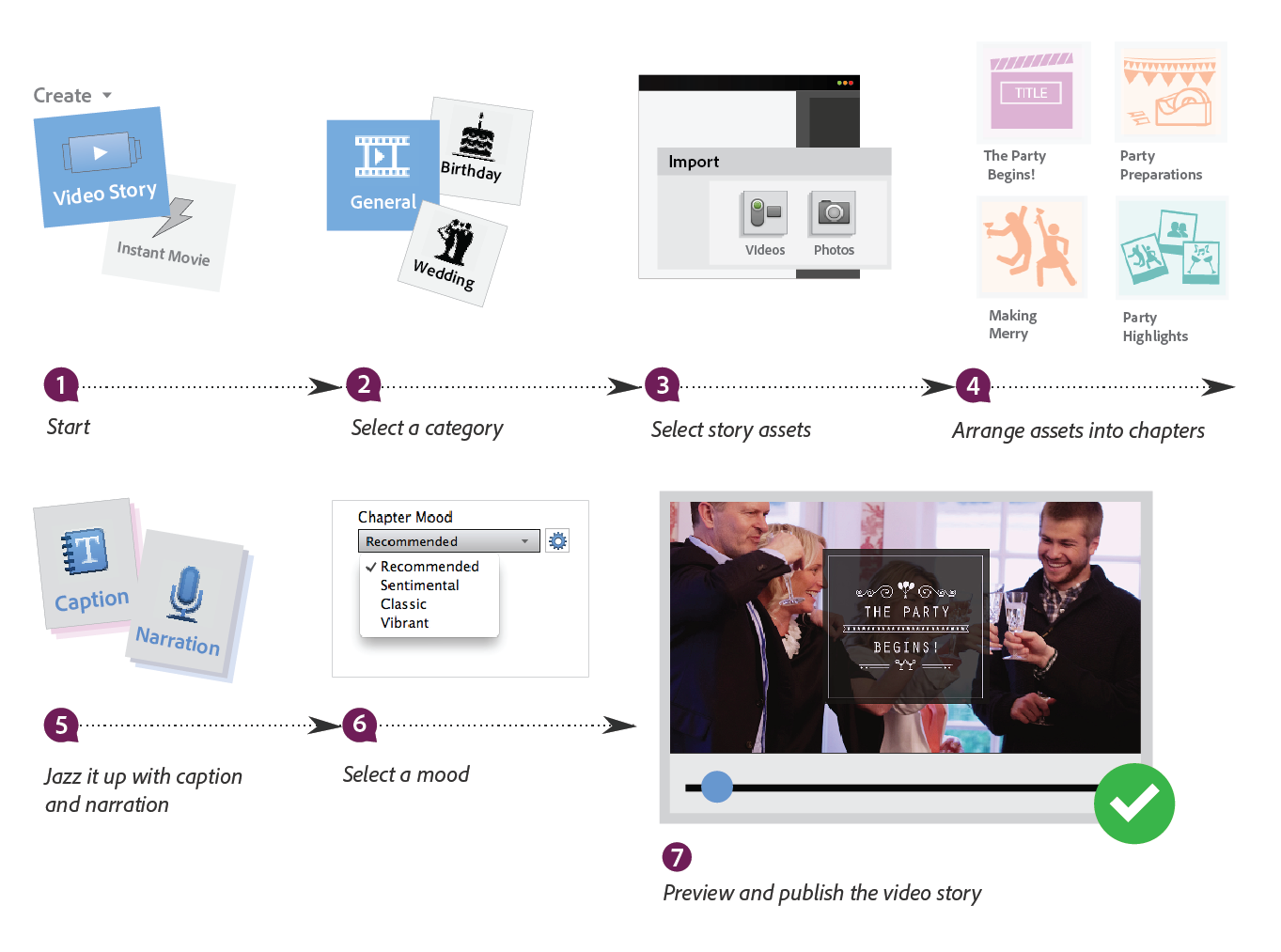

Create a video story
Follow these steps to create a video story:
-
Click Create > Video Story.
Or
Click Make your Video Story from the Premiere Elements start screen.
-
Adobe Premiere Elements displays tips for creating a video story. You can click the left and right arrows and view the tips.
- When you have viewed the tips and want to start creating the video story, click Skip.
- Click Exit to quit the Video Story workflow and return to the application workspace.
NoteClose and relaunch the application if you want to view the tips again.
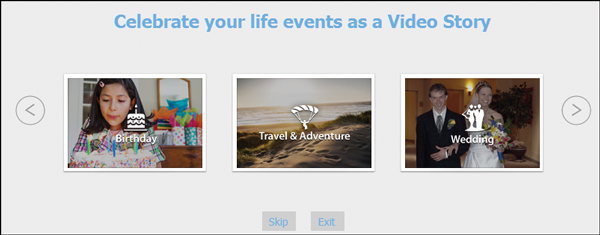
Video story tutorial steps 
Video story tutorial steps -
Choose a category to start creating the video story. Click General to create the video story with a general theme. If the theme is not present on the computer, you will see an Online Content Download that displays content being downloaded for that theme.
-
Click the left/right buttons to browse through the various available themes. The image displayed provides a preview of the selected theme.
Select Use media from my timeline to access videos and photos from your timeline or click Get Started.
The Use media from my timeline option brings all the videos and photos from your timeline to the story asset view in the Video Story workflow.
-
Click a media source from the available import options to import story assets to include in your story. The available media sources from which you can import photos, videos, and audio files are listed below. Click to import media from one of these media sources:
- Elements Organizer: Import videos and photos from Elements Organizer.
- Videos from Flip Or Cameras: Import videos from FLIP, AVCHD cameras, or other memory/disk devices.
- Photos From Cameras or Devices: Import photos from digital cameras, phones, or removable drives.
- Files And Folders: Import videos, photos, and audio files from the hard drive of your computer.
Select the media from the Add Media dialog box and click Open.
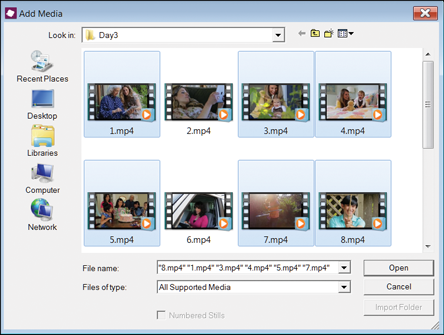
Add media 
Add media -
Click a video to launch a preview of the video clip. Click to select a file and press Delete to remove a file from the story assets. Press Ctrl + A to select all the clips and then Delete to remove them from the selected story asset. The file is not removed from the location in which it is saved.
Click Next. All the files present in Story Assets are included and can be accessed while creating the Story Overview.
-
Now, you can organize the videos and photos in chapters to arrange them in a more structured way. The story is made up of multiple chapters.

Story Overview view 
Story Overview view Organize the videos and photos to structure and manage your video story as chapters. Drag-and-drop story assets from the left pane to the appropriate chapter. For example, drag-and-drop the video footage of pre-party behind the scenes to the Party Preparations feature chapter. Other functions you can perform in the Story Overview view are:
- Add Media: Click Add Media in the Story Assets pane to import more videos and photos.
- Story Title and Story Credits: A Story Title video features as the title chapter. Your video story starts from this video. Similarly, the Story Credits video is the last video of the video story. You can add as many video clips to the other chapters, but only one video can be added to each Story Title and Story Credits chapters.
NotePress Ctrl + S to save while working on your video story to save your work incrementally.
- Add Media: Click Add Media in the Story Assets pane to import more videos and photos.
-
You can manage the chapters in the Story Overview view. Add, hide, or delete to organize the flow of your story:
- Hide Chapter: Click Hide to hide the Story Title and Story Credits chapters. You cannot hide other chapters.
- Add chapter: Click Add Chapter on the Action bar to add another chapter or click Add chapter in the Story Overview panel. You can reorder the clips within a chapter and also reorder chapters to change the flow of the story.
- Preview video clips: Click the play button on a video clip added to the chapters to launch a preview of the clip.
- Undo and Redo: Click Undo or Redo from the Action bar to recall or repeat an action.
Click Next. The Auto Analyzer analyzes and processes the clips.
NoteTo rearrange the order in which clips are played, drag-and-drop the clips inside the chapter to change the order in which they are played in a chapter.
- Hide Chapter: Click Hide to hide the Story Title and Story Credits chapters. You cannot hide other chapters.
-
The chapters are displayed in a linear view in Detail View. Detail View lets you edit the chapters by helping preview the videos, render the videos, mark favorite moments, add captions and narration to the chapters, and so on.
For a quick editing to hide, delete, and overall view of the organization of clips in various chapters, switch to Overview from the top pane.
Preview Chapter: You can click play in the Story Chapters pane to preview a chapter. For more information, read the section Preview a chapter.
If your video story inlcudes image assets, Premiere Elements automatically uses Pan and Zoom for these assets. You can choose to disable Pan and Zoom for all or some of the images in your video story.
-
You can perform the following functions in Detail View:
- Story Title: Edit the title for your video story. Every chapter has a title that can be edited.
- Story Chapters: You can change the order in which chapters appear. Drag-and-drop a chapter to change its order in the Story Chapters pane.
- Story Assets: Click to add media to a chapter.
- Mark Favorite Moments: Hover your mouse over a video clip. Click the star icon to launch favorite moments. You can mark your best moments in a video clip. For more info, see Marking favorite moments.
- Remove videos and photos: Click to select a photo or video and click delete to remove a photo or video from the chapter.
- Add Chapter: Click Add Chapter on the Action bar to add a chapter to the video story.
- Add Caption: Click Add Caption to launch the Caption view to add or edit a caption in the chapter. For more details, read the section Add caption and narration to the workflow.
- Add Narration: Click Add Narration to add or edit narration to the chapter. For more details, read the section Add caption and narration to the workflow.
- Chapter Mood: Click Chapter Mood to select a chapter mood for the chapter. For more details, read the section Change the Mood setting of the chapter.
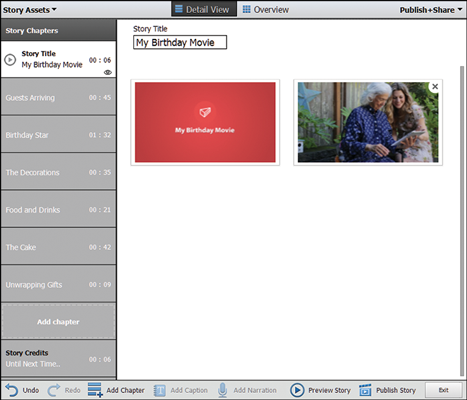
Detail View 
Detail View - Story Title: Edit the title for your video story. Every chapter has a title that can be edited.
-
You can perform various operations on chapters in Overview View, such as:
- Hide Chapter: Click to hide a chapter from the movie. You can hide only the first and last (Story Title and Story Credits) chapters.
- Edit Chapter: Click to edit the chapter.
- Delete Chapter: Click to delete a chapter from the video story.
- Story Title: Edit the story title for your video story. Every chapter has a title that can be edited.
- Remove videos and photos: Click the delete icon to remove a photo or video from the chapter.
- Add Chapter: Click Add Chapter on the Action bar to add a chapter to the video story.
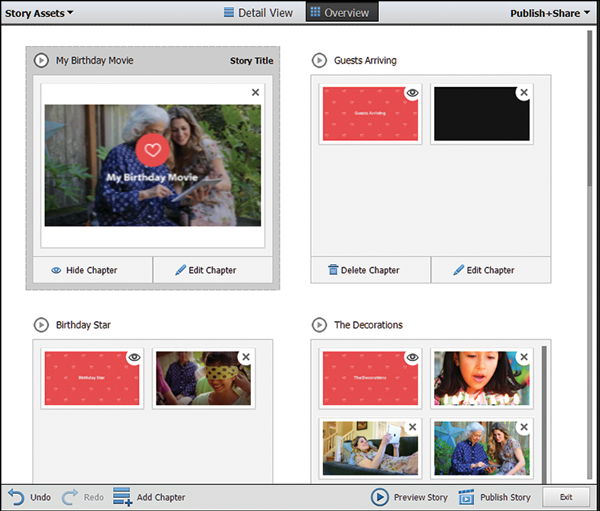
Overview View 
Overview View - Hide Chapter: Click to hide a chapter from the movie. You can hide only the first and last (Story Title and Story Credits) chapters.
-
Click Preview Movie to preview the video story you have created.
-
Click Publish Movie to publish the video story. Select from the Publish+Share option.
Add captions and narration to the workflow
You can add captions and narration to the chapters of your video story to add depth and context. Follow these steps to add a caption or narration to a chapter:
-
Select a chapter in Detail View.
NoteYou cannot add captions and narration to the first and last (Story Title and Story Credits) chapters.
-
Click Add Caption or Add Narration from the Action bar.
-
Move the CTI to the frame in the video clip where you want to add or edit a caption.

Add a caption 
Add a caption Click Add/Edit caption to add or edit the captions.
-
Alternatively, in the previous step, click Add Narration to add narration.

Add narration 
Add narration Click Record to start recording.
Change the Mood setting of the chapter
You can choose a predefined mood by clicking the Settings icon next to the Chapter Mood drop-down. In Detail View, select a chapter and select the Chapter mood from the drop-down list.


You can click Settings to change the music track and the look, or edit the speed of the video clip.
Note: As per the mood of the chapter, some portions of your clip are already automarked. You may tweak them if required.